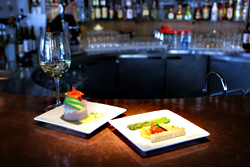Right now, the kind of folks who fly around the world to loll about in five-star hotels are saying that Lima is the most exciting food city in South America. Seems that Peru’s potent indigenous, Spanish, Chinese, African, Italian, and Japanese influences have commingled so long that they finally combusted, producing a flare of creative, refined cuisine. The jetless can simply drive to Kirkland for a taste of this “New Andean” cuisine. Like foie gras and truffles, it’s luxurious—in small doses.
The chef of the nine-month-old Mixtura, Emmanuel Piqueras, made his way from Peru to Kirkland via Spain, where he trained under three-star chef Juan Mari Arzak, and then Portland, where he caused a stir with his restaurant Andina. Mixtura’s Peru-born owners, Gus Rivadeneira (from Portland) and Oscar Acosta (from Vancouver, B.C.), used to converge at Andina for meals, and finally lured the chef to Kirkland, midway between their two cities and ripe for a new upscale restaurant.
Piqueras’ new Andean cuisine combines the Pacific Northwest love for fresh fish and fried food with South American grains, chiles, and potatoes many of us have never seen before. He reinvents stick-to-your-ribs classics as lovely, delicately layered caprices. For example, Peruvians, who claim to have invented ceviche, eat the stuff by the platter, but Piqueras strips his cebiche cinqo elementos ($12) down to a mere allusion of its origins: a few all-but-transparent slices of mahi mahi, so lightly dressed that they resemble sashimi; a few shavings of red onion; slivers of golden habaneros. He evokes the boiled corn cob and crunchy fried corn kernels that commonly accompany cebiche cinqo elementos with a scattering of blanched field corn, and replaces the puck-sized slab of sweet potato with a slim orange disk.
Not just a cultural expedition, the chef’s menu is filled with fanciful dishes matched up with Spanish wines and kickass cocktails, such as an über-classic pisco sour ($9) frothed with beaten egg whites. The restaurant, too, is more 21st century than Machu Picchu—a lattice of exposed steelwork and ducts above, burnished wood floors below, with a showcase kitchen at the back so you can ogle the cooks while you eat. The owners nod to Peru with a wall of black-and-white pottery and pictures of Incan artifacts silk-screened onto boldly colored canvases. As long as there’s still a menu item to describe, a plate to clear, or a glass of wine to sell, the servers are at your shoulder the moment you look up from the table.
The bulk of Mixtura’s menu is mixturas, or small plates, served tapa size (gone in a few bites) or appetizer size (which might last on the table for few seconds longer). You can compose a meal of two to three mixturas of either size per person, or go all out with fondos, or entrées.
Except . . . don’t. Overburdened by whimsy, all the fondos I tried were at first captivating, then puzzling, and finally unsatisfying, in a rambling Life Aquatic With Steve Zissou way. Not that the sight of them didn’t stop the breath: seared sea scallops wrapped in serrano ham lined up on a stripe of sauce, flanked by a black strip of squid ink and deep-fried carrot curls on one side, and on the other, a row of stacks of mango, fresh mozzarella, and poached prawns. Regretfully, the elements didn’t hang together. The mango “ravioli” were all bland sweetness, sharing nothing in common with the salty scallops. Similarly, a “deconstruction” of arroz con pato, traditionally a dish of rice and duck, contained a wonderful but almost raw duck breast (I like mine medium-rare to medium, thanks) and duck leg confit deep-fried in a frilly rice-flour batter, a cute trick that nevertheless toughened the meat.
Life Aquatic didn’t spoil me on Wes Anderson. Likewise, I left my first meal at Mixtura a fan of Piqueras but determined to stick to his less epic works. My opening-night desserts proved the point—a molten chocolate cake ($9) with passion fruit “ecstasy” (read: puree) and three traditional Peruvian desserts in miniature ($7; chocolate truffles, a custardy milk caramel, saffron rice pudding in a lacy cookie), which one friend called “butter three ways.”
I came back to Mixtura for a second, nearly pitch-perfect meal of just small plates: Coiled octopus tentacles “char-grilled” ($5.50/10) and smeared with a nutty, roast-chile pesto. Causa morada marina (tapa $7, appetizer $13.50), a gorgeous tower of creamy blue potato puree with lime-sparked crab meat, prawns, and smoked salmon in the center and a tomato rose on top. And another, even more lovely “tiradito marino en mosaico” cebiche ($16), this one sliced poached prawns, the creamiest octopus I’ve tasted in years, and raw mahi mahi fanned along thick lines of lime and chile cream sauces. Owner Rivadeneira claims that the fish for such a cebiche must never be frozen, so he has it flown in from Hawaii every day. A sentiment that, to Mixtura’s target audience, may seem only practical.






